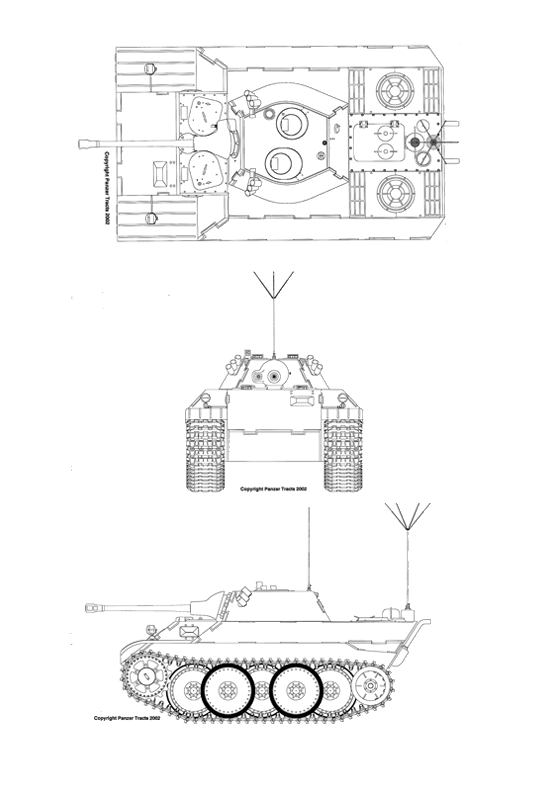
Gefechtsaufklaerer “Leopard” VK 16.02
The “Leopard” VK 16.02
In mid-1941, M.A.N was working on the design of the VK 16.02 for which they had received a contract for the completion of Versuchsfahrgestelle. By the end of November 1941, M.A.N. has completed the drawings for the wooden mock-up of the VK 16.02 (m) revealing a chassis with well-slopped armor (similar to the Pz.Kpfw. V Sd.Kfz. 171 “Panther” design of M.A.N.). It had thicker armor than the Panther with an 80mm glacis plast set at 55 degrees to the vertical, 80mm lower hull front at 55 degrees, 60 mm upper side plates at 40mm, 60mm lower side plates at 0 degrees, 50mm rear plate at 30 degrees and 20mm plates for the deck and belly. In order to aid M.A.N. engineers in the delaying of the VK 16.02 project, which had become very important in recent plans, Wa Pruef 6 decided to turn detailed design of the chassis over to MIAG in January 1942. The turret with the 5cm Kw.K. L/60 as the main armament was being designed by Daimler-Benz.
Based on the Wa Pruef 6 data sheets, the final version of the Panzerkampfwagen Leopard had a combat load of 21.9 metric tons. It was not a small vehicle with an overall length of 4.74 meters, width of 3.10 meters and a height of 2.60 meters with a ground clearance of 0.50 meters. Power was provided by a water cooled Maybach HL 157 gasoline engine (rated at 550 metric horsepower at 3600 rpm) was transferred through a Maybach OG 55 11 17 semi-automatic transmission, to the multi-stage steering unit, and final drives to the sprockets driving 660mm wide tracks. In the end, the Leopard was to have the same tracks as the Panther (previous specifications had called for 650mm wide tracks with 150mm pitch) providing very good floatation at 0.71 kg/sqcm ground pressure. Maximum speed was 60 km/hr with sustainable speed on improved roads and 30 km/hr cross-country. It was designed to climb 30 degree slopes, climb ober 0.85 meter tall steps, cross 2.3 meter wide trenches and ford bodies of water up to 5.0 meters deep. The five 960mm road-wheels were inter-leavened to reduce ground contact length to 2.420 meters, it had achieved the ultimate goal in steering ratios of very close to 1.
The main armament was mounted in the turret with a coaxial 7.92mm MG 42 (with a much higher cylic rate than the MG34) Stowage was provided for 50 rounds of 5 cm Pzgr. and Sprgr. and 2400 rounds of 7.92mm SmK.
The Well slopped frontal armor provided adequate protection against all but the most powerful Allied anti-tank guns. While similar in general shape to the turret mounted on the s.Pz.Sp.Wg. (Sd.Kfz. 234/2) “Puma”, the turret for the Leopard was larger and had thicker armor sloped at greater angles. the 50mm turret front plate was set at 20 degrees, 30mm side and rear plates at 30 degrees, and 16mm roof plate at horizontal.
An Fu 2 or Fu 5 radio set was standard with an Fu 8 provided for communication between the four crew members consisting of a driver, loader/radio operator, gunner and commander.
Before the first production series Leopard entered the assembly line, Hitler decided on 3 January, 1943 that the Leopard was to be dropped from he Panzerprogramm because its armor and armament (even as a reconnaissance vehicle) did not meet the specifications that would arise in 1944

(Above) Armor arrangement for the VK 16.02 (M) as intended in November 1941. The 80mm thick front plates and 60mm side plates on the VK 16.02 (M) were thicker than the 60mm front and 40mm sides on the VK 30.02(m) design from May 1942.

(Above) The final production layout of the Leopard.